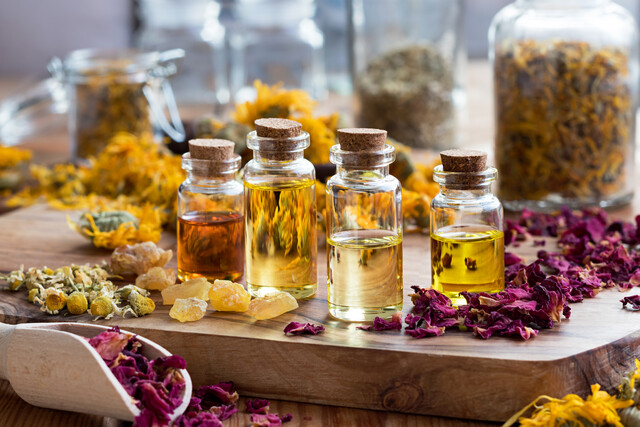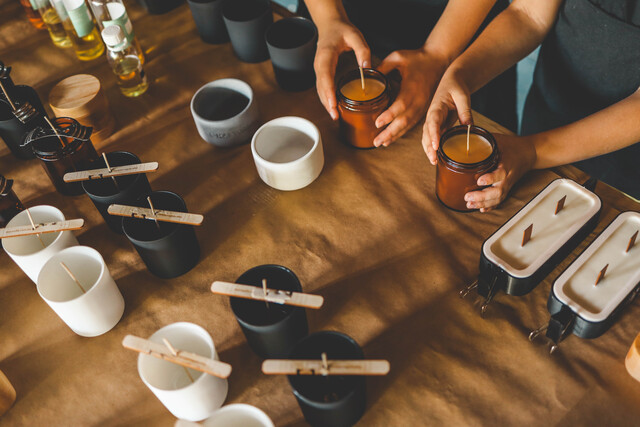Objectives
In this article, you will learn about the various types of skin and their individual challenges. You'll also learn to identify your own skin type, and be a step closer to finding your ideal personal skin care regimen.
Section 1. All Skin is Not the Same.
You may think that skin is skin, and we all have pretty much the same thing covering our bodies, but that is far from the truth. There are many variations in skin density, pigment, and moisture level. This all affects how our skin looks, and how we need to care for it.
Understanding your particular skin type and its needs can unlock a huge mystery if you have previously struggled to manage your skin. Often, people are doing the exact wrong things for their skin type and unwittingly making their problems worse. The skin care industry understands this concept well, which is why you see so many products targeted to treat specific types of skin and skin problems.
It's important to note that a person can have different skin types throughout their lives. The skin you had as a child is most likely not what you will end up with as an adult. Also, hormonal changes, illness, the seasons, and aging can drastically change the appearance of your skin. If you are familiar with the various skin types, you will be able to adequately care for your skin, no matter what the situation.
Section 2. Normal Skin
Normal skin is considered skin that is neither overly oily nor very dry. People with normal skin have less occurrences of acne than those with oily skin as their oil and sweat glands usually maintain a consistent and optimal production level.
Normal skin types will have small pores and an even texture. Normal skin types often have a rosy glow to their cheeks, which is evidence of good circulation in the blood vessels of the dermis.
Normal skin does, however, require regular maintenance -- including proper cleansing and moisturizing. People with normal skin often skip the step of toning, but it can still be beneficial.
Section 3. Combination Skin
Combination skin is often grouped with normal skin, but it has its own distinct challenges. With this skin type, part of the face, usually the forehead, nose, and chin (called the "T-zone") are extra oily, while the cheeks and eye area tend to be normal or dry.
Combination skin type can be frustrating, as it requires extra care to ensure that each area is treated according to its needs. You have to be careful to cleanse the T-zone well, without over-drying other parts of the face. Many people think there is no hope for combination skin, but with proper nutrition and maintenance, it is possible to achieve a more even skin type.
Section 4. Oily Skin
Often, people with oily skin excessively scrub their face, often with harsh cleansers. Also, they tend to use toners multiple times a day and might use harsh acne medication containing benzyl peroxide, which is extremely drying.
What most people don't know constantly scrubbing and drying out the skin actually makes the problem of oily skin worse. Your skin naturally creates oil (sebum) which is needed to keep the skin supple and moisturized. If you are constantly removing every trace of oil, this signals to the oil producing glands that there is a shortage and that it needs to make more.
The best defense against oily skin is to assess your diet and environment for things that may be causing increased oil production and cleanse with a natural, non drying soap. And contrary to popular belief, oily skin types still need to apply moisturizer after washing. However, it should be one that is non-comedogenic (non-pore clogging). Good options are Cetaphil lotion, which can be found in most pharmacies and also emu oil, which is non-comedogenic and also fights bacteria.
Section 5. Dry Skin
As we learned, the skin produces sebum to keep its surface moisturized. Individuals with dry skin have under-active oil glands, which limit the amount of moisture produced. As a result, there is dry, often itchy, skin that can appear dull and lackluster. The skin can also flake and crack due to the lack of moisture.
If you suffer from dry skin, drinking more water may correct the problem. If you are dehydrated, the body diverts water from less needed areas to fuel vital body functions and organs. Compared to the brain, kidneys, and blood, the skin can more afford to go without water. Focusing on re-hydrating yourself can help greatly.
Other reasons for dry skin include using heaters in the winter. As they warm a room, heaters pull water from the air and dry out the environment in the house. Constantly using a heater, especially overnight, can cause not only dry skin, but dry eyes and throat as well. To combat this, place a bowl of water in front of heaters, so that the moisture inside evaporates into the air. This helps the moisture level remain optimal. Another option is to spray your face with a mist of water and vegetable glycerin, which is a natural humectant (draws moisture to your skin).
People with oily, dry, or combination skin can also have what is termed "sensitive skin." This usually means that their skin reacts quickly and negatively to cleansers, lotions, irritating clothing, and items such as, fabric softeners and clothing detergent.
People with sensitive skin may often have red patches or rashes as a result of contact with something. For this skin type, it is best to avoid chemicals and use natural soaps and moisturizers. This greatly reduces irritation, redness, and drying.
Anyone can have sensitive skin, but is also a special concern for patients undergoing chemotherapy, burn victims, and babies.
Food for Thought
Were you aware that there were so many skin types? Did you clearly see yourself in one of the descriptions? How might you modify your skin care routine based on what you have learned?
Conclusion
Developing a Natural Skin Care Routine
Objectives
Now you will learn the best way to care for your skin, as well as what products work best, and which to avoid.
Section1. Why have a Routine?
There are many things that you can do one day and ignore the next. However, caring for your skin should not be one of them. Your skin needs consistent care and attention in order to maintain health and vibrancy over the long term. Sometimes younger people can get away with not having a routine for a while, but the effects of this will most likely show as they age.
Developing a skin care routine allows you to:
-
Learn your skin and what it needs, especially during different seasons
-
Maintain a healthy cleansing regimen and avoid breakouts and blemishes
-
Regularly and thoroughly remove makeup that can clog pores and irritate the skin
-
Consistently exfoliate dead skin cells and maintain a bright, even complexion
Section 2. Components of your Skin Care Routine
There are four major components to an effective skin care routine: cleansing, toning, moisturizing and exfoliation. Let's examine the benefits of each.
Cleansing- Your skin is your largest organ and is exposed to the harsh elements on a daily basis. This includes dirt and dust, chemicals, sweat, and a host of other things. If you fail to properly cleanse your skin on a regular basis, it will become dry and weathered, the pores clogged, and the overall appearance will be diminished.
Cleansing the skin also helps to improve blood flow below the skin's surface and eliminate waste and toxins effectively. A proper cleansing regimen helps you to avoid blackheads and whiteheads, as well as effectively removes makeup that can ravage the skin over time.
Some tips for cleansing your skin:
-
Wash your face in a circular motion, which stimulates blood flow. When scrubbing your body, use circular motions, moving upwards towards your heart.
-
Avoid the sensitive eye area when washing your face, as the capillaries (small blood vessels) under the eye can easily break and cause a bruised, puffy look.
-
Avoid harsh chemical cleansers that can dry out your skin or cause an allergic reaction.
-
Always wash at least first thing in the morning and before going to bed to remove residue and perspiration.
-
Avoid scrubbing your face hard, especially if it is irritated or has blemishes.
Toning- After a long day, there is often a lot of buildup on the surface of the skin that may not be totally removed just by washing. Toning acts as a second round of defense against makeup, oil, and dirt. Toners also contain astringents, which are said to help cleanse pores and reduce their size.
Most commercial toners contain alcohol and can be drying to the skin if used too frequently. Some good natural astringents are Witch Hazel, Sandalwood, and Lemon. Also, if you have normal or sensitive skin, you may want to avoid an astringent altogether and focus more on washing and moisturizing.
Moisturizing- This is one of the most important elements of your skin care routine. Your skin requires ample moisture to maintain its appearance, elasticity and function. Failure to develop a habit of moisturizing your skin can lead to premature signs of aging and a general lack of luster. In fact, without moisture, the skin can become dry, gray, and ashy. Dry skin literally drinks in moisture, so it is important to give it what it needs.
Moisturizing from the Inside
To maintain optimal moisture levels, it's important to not only moisturize the skin on the outside, but from the inside as well. While outside moisture application is very important, nourishing your skin from the inside is often more so.
Ensuring that you drink adequate amounts of water is one of the most important means of nourishing your skin from within. The body is largely made up of water, which is required to maintain health and vitality in every cell and organ. Drinking large amounts of water hydrates the skin from the inside and gives the skin cells a plump, healthy appearance, as opposed to dry and wrinkled. In addition to drinking water, eating a good amount of watery fruits and vegetables is also beneficial. If you're not a big vegetable fan, blending them with fruits to make a smoothie can be a better option.
External Moisturizing
The goal of applying moisturizer to your skin is to help replenish the moisture that is diminished through exposure to the elements, cleansers that remove oil, and also to help reduce the signs of aging. To produce the best results, it's best to use natural moisturizers.
Using synthetic or chemical moisturizers is not really providing much benefit to your skin. The petrochemicals that many of these products contain actually clog pores and can cause breakouts and rashes. The goal of a great moisturizer includes the following:
-
Penetrates deeply
-
Actually provides moisture, instead of just coating the skin
-
Contains antioxidants that reduce the effect of free radicals
-
Does not clog pores
-
Has soothing or healing properties
-
Does not contain dyes and synthetic fragrances
Exfoliation- Removing dead skin is a very important component of your skin care regimen. The top layer of skin regenerates every month and if the old, dead layers are not removed, they will clog your pores and dull the complexion. By exfoliating regularly, you allow the new, vibrant skin to shine through. This can be done with a citrus or sugar scrub, as well as a textured clay mask.
Section 3. Routines Based on Skin Type
As we learned, everyone has a different skin type and some people have more than one. There are a few skin type-specific elements that you can integrate into your routine to receive the best results and minimize extra hassle.
Below are components and tips for the various skin types:
Normal Skin Care Routine- This skin type can get away with using a mild cleanser, and sometimes simply using water is sufficient. The face should be washed twice a day and toner can be applied if desired. People with normal skin can tolerate normal to thick moisturizers, but should avoid too much oil, as their sebum production is already very balanced. Normal skin types should exfoliate at least once a week.
Oily Skin Care Routine- Those with oily skin should focus initially on understanding the reasons for their extra oil production. Do you eat a lot of junk or oily foods? Are you washing too frequently, causing the skin to overproduce oil in an effort to maintain balance? Are there hormonal issues? These, in addition to smoking and pregnancy are some of the reasons for oily skin.
As for your skin care routine, choose a cleanser that is especially formulated to cut through oil without drying out the skin, such as natural castile soap. Diluting Dr. Bonners peppermint or lavender castile soap is a good option. It cleanses thoroughly, while stimulating the skin. Other good options include yogurt, apple cider vinegar and milk.
Moisturizers used on oily skin are usually cream-based, which provides moisture without added oils. Great oily skin moisturizers may include ingredients such as aloe vera, chamomile, lavender, oat straw and thyme. A toner containing lemon juice or witch hazel can be used before applying moisturizer.
Dry Skin Care Routine- Dry skin can be very irritating and hard to manage. Your goal is to infuse the skin with as much moisture as possible. Cleansers should include natural ingredients such as aloe vera, milk and honey, avocado, oatmeal, etc. These all will soften and heal the dry skin, and will allow for much easier exfoliation as well.
When is comes to toning, this is not recommended as it will most likely dry out already parched skin. However, a facial steam can be done to open pores and allow for the easy removal of blackheads.
Food for Thought
Do you currently have a skin care routine? Do you incorporate specific types of products ,or mainly just buy what's on sale? How might you alter your routine going forward?
Conclusion



























